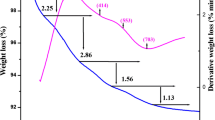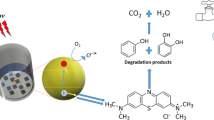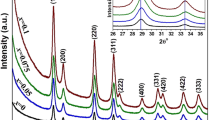Abstract
CeO2 nanoparticles are synthesized at different reaction times, different reaction temperatures, and different pH of the starting precursor solution. Metal (Ni2+, Cd2+, and Nb5+) doped CeO2 nanoparticles are prepared with different concentrations of dopant ions by maintaining the reaction time at 24 hrs, reaction temperature at 180 °C, and pH of the starting precursor solution at 12. The physical properties of the prepared samples are studied by powder X-ray diffraction analysis (PXRD), scanning electron microscopy (SEM), Brunauer–Emmett–Teller (BET) specific surface area analysis, Fourier transform infrared spectroscopy (FTIR), Raman spectroscopy, UV–visible spectroscopy (UV–vis), and photoluminescence (PL) analysis. The photocatalytic activity of the prepared samples is studied by methylene blue (MB) degradation under sunlight irradiation. The effect of reaction time, reaction temperature, pH of the starting solution, and dopant ions concentration on the physical properties and photocatalytic activity of CeO2 nanoparticles are analyzed. All the synthesized samples are found to have a cubic fluorite structure. The crystallite size and lattice parameter of undoped CeO2 nanoparticles increase with the reaction time, reaction temperature, and pH of the precursor solution used for the synthesis and decrease with the dopant ions concentration. All of the samples have spherical morphology, as seen by SEM pictures. With increasing reaction time, reaction temperature, precursor solution pH, and dopant concentration, the particle size drops, and the specific surface area increases. However, for Nb5+ ions doped CeO2 nanoparticles, a decrease in the specific surface area with doping is observed which may be due to the formation of the fergusonite (CeNbO4) phase at higher doping levels. FTIR analysis confirms the presence of Ce–O-Ce or Ce–O-M stretching vibrations in the samples. The bandgap energy of Ni2+ doped samples increase from 3.57 to 3.85 eV and that of Cd2+ doped samples increases from 3.55 to 4.03 eV when the dopant concentration is increased from 5 to 15 M%. The observed increase in the bandgap energy of the Ni2+ and Cd2+ doped CeO2 samples could be due to the decrease in the particle size. The bandgap energy of Nb5+ ions doped CeO2 nanoparticles decreases with an increase in dopant concentration which could be ascribed to the increased formation of the Fergusonite phase at a higher doping level. A shift in the F2g peak position towards lower wavenumbers and a reduction of peak intensity with increased doping is observed in the Raman spectra confirming the enhancement of oxygen vacancies with an increase in dopant concentration. The PL studies show that the CeO2 nanoparticles and Ni2+, Cd2+, and Nb5+ ions doped CeO2 nanoparticles exhibit luminescence in the violet-blue-green wavelength region. The PL emission intensity of the doped samples decreases as the dopant concentration increases. The undoped CeO2 nanoparticles prepared at higher reaction time, higher reaction temperature and higher pH (= 12) of the precursor solution exhibit higher photocatalytic activity. In the case of doped CeO2 samples, the MB degradation efficiency of Ni2+ ions doped CeO2 NPs is found to be comparatively higher than that of undoped and Cd2+ and Nb5+ doped CeO2 NPs. 15 M% Ni2+ doped CeO2 NPs exhibited smaller particle size, higher specific surface area of 49.7m2/g and a higher MB degradation efficiency of 81.9% within 1 hr.














Similar content being viewed by others
Data availability
The datasets generated during and/or analyzed during the current study are available from the corresponding author on reasonable request. All data generated or analysed during this study are included in this published article.
References
Ardila Leal LD, PoutouPinales RA, Pedroza Rodriguez AM, Quevedo Hidalgo BE (2021) A brief history of colour the environmental impact of synthetic dyes and removal by using laccases. Molecules 26(13):3813
Bruno L (2019) FavaroPolonio, Cíntia Zani Pamphile, Joao Alencar, Polonio, Julio Cesar, Effects of textile dyes on health and the environment and bioremediation potential of living organisms. Biotechnol Res Innovation 3(2):275–290
Mohamed B, Rachid H (2019) Khudhair Mohammed; AssouagMohammed, Cherkaoui Omar, El BachiriAbderrahim, El Harfi Ahmed, Textile finishing dyes and their impact on aquatic environs. Heliyon 5(11):e02711
Lellis B, FavaroPolonio CZ, AlencarPamphile J, Cesar Polonio J (2019) Effects of textile dyes on health and the environment and bioremediation potential of living organisms. Biotechnol Res Innovation 3(2):275–290
Elsahida K, Fauzi AM, Sailah I, Siregar IZ (2019) Sustainability of the use of natural dyes in the textile industry. IOP Conference Series: Earth and Environ Sci 399:012065
Dawoud TMS, Pavitra V, Ahmad P, Asad Syed G, Nagaraju, (2020) Photocatalytic degradation of an organic dye using Ag-doped ZrO2 nanoparticles: milk powder facilitated eco-friendly synthesis. J King Saud University Sci 32:1872–1878
Hasan J, Li H, Tian G, Qin C (2020) Fabrication of Cr2S3-GO-TiO2 composite with high visible-light-driven photocatalytic activity on degradation of organic dyes. Chem Phys 539:110950
Kaid MM, Elbanna O, El-Hakam SA, El Kaderi HM, Ibrahim AA (2022) Effective photocatalytic degradation of organic dyes using ZNC/rGO nanocomposite photocatalyst derived from ZIF-8/rGO thermolysis for water treatment. J Photochem Photobiol, A 430:114001
Safat S, Buazar F, Albukhaty S, Matroodi S (2021) Enhanced sunlight photocatalytic activity and biosafety of marine-driven synthesized cerium oxide nanoparticles. Sci Rep 11:14734
P. Li, W. Zhang, X. Zhang, Z. Wang, X. Wang, S. Ran, V. Yaohui, 2018 Synthesis, characterization, and photocatalytic properties of flower-like Mn-doped ceria, 21(5) 20180167
Ilaria P, Attilio M, Serena DT, Claudia N, Stefano D, Valentina C, Mauro G, Paola P, Filippo SM, Virgilio M, Gianni C (2017) Cerium oxide nanoparticles: the regenerative redox machine in bioenergetic imbalance. Nanomedicine 12(4):403–416
Rafael AC, Amoresi C, Cristina de Oliveira R, Marana NL, Barros de Almeida P, Santana Prata P, Zaghete MA, Longo E, Sambrano JR, Simoes AZ (2019) CeO2 Nanoparticle morphologies and their corresponding crystalline planes for the photocatalytic degradation of organic pollutants. ACS Appl Nano Mater 2(10):6513–6526
Kusmierek E (2020) A CeO2 semiconductor as a photocatalytic and photo electrocatalytic material for the remediation of pollutants in industrial wastewater: a review. Catalysts 10(12):1435
D. Ayodhya, A. Ambala, G. Balraj, M. Pradeep Kumar, P. Shyam, 2022 Green synthesis of CeO2 NPs using Manilkarazapota fruit peel extract for photocatalytic treatment of pollutants, antimicrobial, and antidiabetic activities, Results in Chemistry, 4 10441.
Chen Y, Wang T, Pan J, H. (2022) Menghan Fabrication, characterization and photocatalytic degradation activity of PS/PANI/CeO2 tri-layer nanostructured hybrids. Bull Mater Sci 45:1–9
H.S. Wasly, M.S. Abd El‑Sadek, M. Henini, 2018 Influence of reaction time and synthesis temperature on the physical properties of ZnO nanoparticles synthesized by the hydrothermal method 124 76–88
Mishraa S, Sorena S, Debnathc AK, Aswalc DK, Dasb N, Parhi P (2018) Rapid microwave Hydrothermal synthesis of CeO2 nanoparticles for simultaneous adsorption/photodegradation of organic dyes under visible light. Optik - Int J Light and Electron Optics 169:125–136
Gnanam S, Gajendiran J, RamanaRamya J, Ramachandran K, Gokul Raj S (2021) Glycine-assisted hydrothermal synthesis of pure and europium doped CeO2 nanoparticles and their structural, optical, photoluminescence, photocatalytic and antibacterial properties. Chem Phys Lett 763:138217
Honey S, Ahmad I, Madhuku M, Naseem S, Maaza M, Kennedy JV (2017) Nickel nanowires mesh fabricated by ion beam irradiation-induced nanoscale welding for transparent conducting electrodes. Material Research Express 4:075042
Mirzazadeh H, Lashanizadegan M (2020) Ag2O/CdO/CeO2 reduced graphene oxide: synthesis, characterization and its application as catalyst for sulfasalazine, diclofenac and phenol degradation under ultrasonic irradiation. Mater Res Express 7:065008
Durai D, Prabaharan M, Sadaiyandi K, Mahendran M, Sagadevan S (2018) Investigating the effect of Mn-doped CeO2, nanoparticles by coprecipitation method. Appl Physics A Mate Sci Processing 124:86–92
Ortega PP, Rocha LSR, Cortesa JA, Ramireza MA, Buonob C, Ponce MA (2019) Towards carbon monoxide sensors based on europium doped cerium dioxide. Appl Surf Sci 464:692–699
Kaviyarasu K, Maria Magdalane C, Jayakumar D, Samson Y, Bashir AKH, Maaza M, Letsholathebe Douglas, Mahmoud Ahmed Hossam, Kennedy J (2020) J King Saud University-Sci 32(2):1516–1522
Panimalar S, Logambal S, Thambidurai R, Inmozhi C, Uthrakumar R, Muthukumaran A, Rasheed Rabab Ahmed, Gatasheh Mansour K, Raja A, Kennedy J, Kaviyarasu K (2022) Environmental Research 205:112560
Panimalar S, Subash M, Chandrasekar M, Uthrakumar R, Inmozhi C, Al-Onazi Wedad A, Al-Mohaimeed Amal M, Chen TW, Kennedy J, Maaza M, Kaviyarasu K (2022) Reproducibility and long-term stability of Sn doped MnO2 nanostructures: Practical photocatalytic systems and wastewater treatment applications. Chemosphere 293:133646
Raj Ali S, Kumar R, Kadabinakatti SK, Chandra Arya M (2019) Enhanced UV, and visible light-driven photocatalytic degradation of tartrazine by nickel-doped cerium oxide nanoparticles. Mater Res Express 6:025513
N. Gokon, T. Suda, T. Kodama, 2015 Oxygen and hydrogen productivities and repeatable reactivity of 30-mol%-Fe-, Co-, Ni-, Mn-doped CeO2-d for thermos chemical two-step water-splitting cycle, 2351–10
P. Kumar Sharma, O.P. Pandey, 2022 Enhanced photocatalytic activity with metal ion doping and co-doping in CeO2 nanoparticles, Solid State Sciences, 126 106846
G. Murugadoss, D. Dinesh Kumar, M. Rajesh Kumar, N. Venkatesh, P. Sakthivel, 2021 Silver decorated CeO2 nanoparticles for rapid photocatalytic degradation of textile rose bengal dye, Scientific Reports, 11 1080.
Qi Ye, Ye J, Zhang S, Tian Q, Nuo Xu, Tian P, Ning G (2019) Controllable synthesis of transition metal ion-doped CeO2 micro/nanostructures for improving photocatalytic performance. J Alloy Compd 782:780–788
Gnanam S, Rajendran V (2018) Facile sol-gel preparation of Cd-doped cerium oxide (CeO2) nanoparticles and their photocatalytic activities. J Alloy Compd 735:1854–1862
Alla SK, Komarala EVP, Mandal RK, Prasad NK (2016) Structural, optical and magnetic properties of Cr-substituted CeO2 nanoparticles. Mater Chem Phys 182:280–286
Saranya J (2014) Kugalur Shanmugam Ranjith, Padmanaban Saravanan, Devanesan Mangalaraj, Ramasamy Thangavelu, Rajendra Kumar, Cobalt-doped cerium oxide nanoparticles: enhanced photocatalytic activity under UV and visible light irradiation. Mater Sci Semicond Process 26:218–224
Lavanya N (2018) Jean Nizeyimana Claude, C Sekar, Electrochemical determination of purine and pyrimidine bases using copper doped cerium oxide nanoparticles. J Colloid and Interface Sci 530:202–211
E. Ramirez Cabrera, A. Atkinson, D. Chadwick, Reactivity of ceria, 2002 Gd- and Nb-doped ceria to methane. Applied Catalysis B: Environmental 36 193–206
E. Ramirez Cabrera, N. Laosiripojana, A. Atkinson, D. Chadwick, 2003 Methane conversion over Nb-doped ceria, Catalysis Today 78 433–438.
Araujo VD, Avansi W, de Carvalho HB, Moreira ML, Longo E, Ribeirod C et al (2012) CeO2 nanoparticles synthesized by a microwave-assisted hydrothermal method: evolution from nanospheres to nanorods. CrystEng Comm 14:1150–1154
Kepenekci O (2010) MehtapEmirdag-Eanes, Mustafa M Demir, Effect of alkali metal hydroxides on the morphological development and optical properties of ceria nanocubes under hydrothermal conditions,. Nanoscience and Nanotechnology 10:1–13
Kennedy J, Murmu PP, Gupta PS, Carder DA, Chong SV, Leveneur J, Rubanov S (2014) Effects of annealing on the structural and optical properties of zinc sulfide thin films deposited by ion beam sputtering. Material Science in Semiconductor Process 26:561–566
Bear Joseph C, Mc Paul D, Naughter Paul Southern, Brien Paul O, Dunnill Charles W (2015) Nickel-doped ceria nanoparticles: the effect of annealing on room temperature ferromagnetism. Crystals 5:312–326
D. Paul Joseph, C. Venkateswaran, 2011 Bandgap engineering in ZnO by doping with 3d transition metal ions, Journal of Atomic, Molecular, and Optical Physics, 2011 270540.
G. Murugadoss, J. Ma, X. Ning, M. Rajesh Kumar, 2019 Selective metal ions doped CeO2 nanoparticles for excellent photocatalytic activity under sun light and supercapacitor application, Inorganic Chemistry Communications, 109 107577.
Pop O, Diaconeasa Z, Mesaroş A, Cristian Vodnar D, Cuibus L, Ciontea Lelia (2015) FT-IR studies of cerium oxide nanoparticles and natural zeolite materials, Bulletin of University of Agricultural Sciences and Veterinary Medicine Cluj-Napoca. Food Sci Technol 72(1):50–55
Jayakumar G, Albert Irudayaraj A, Dhayal Raj A (2017) Particle size effect on the properties of cerium oxide (CeO2) nanoparticles synthesized by hydrothermal method Mechanics. Mater Sci Eng J Magnolithe 9(1):1–6
Dos Santos ML, Lima RC, Riccardi CS, Tranquilin RL, Bueno PR, Varela JA et al (2008) Preparation and characterization of ceria nanospheres by microwave-hydrothermal method. Mater Lett 62:4509–4511
O. A. Maslova M. R. Ammar, G. Guimbretiere, J. N. Rouzaud, P. Simon, 2012 Determination of crystallite size in polished graphitized carbon by Raman spectroscopy. Physical Review B, 86(13) 134205
Gallucci N, Vitiello G, Di Girolamo R, Imbimbo P, Monti DM, Tarallo, et al (2021) Towards the development of antioxidant cerium oxide nanoparticles for biomedical applications: controlling the properties by tuning synthesis conditions. Nanomaterials 11(2):542
Liu L, Shi J, Zhang X, Liu J (2015) Flower-like Mn-doped CeO2 microstructures: synthesis, characterizations, and catalytic properties. J Chem 2015:254750
K.C. Anjaneya, G.P. Nayaka, J. Manjanna, G. Govindaraj, K. N. Ganesha, 2013 Preparation and characterization of Ce1-xGdxO2-δ (x = 0.1 - 0.3) assolid electrolyte for intermediate temperature SOFC, J. Alloys and Compounds, 578 53–59.
Murmu PP, Mendelsberg RJ, Kennedy J, Carder DA, Ruck BJ, Markwitz A, Reeves RJ, Malar P, Osipowicz T (2011) Structural and photoluminescence properties of Gd implanted ZnO single crystals. J Appl Phys 110:033534
Kaviyarasu K, Murmu PP, Kennedy J, Thema FT, Letsholathebe D, Kotsedi L, Maaza M (2017) Structural, optical and magnetic investigation of Gd implanted CeO2 nanocrystals. Nucl Instrum Methods Phys Res, Sect B 409:147–152
Wang L, Meng F, Li K, Fei Lu (2013) Characterization and optical properties of pole-like nano-CeO2 synthesized by a facile hydrothermal method. Appl Surf Sci 286:269–274
Hou D, Han B, Chen W, Liang H, Qiang Su et al (2010) Luminescence of Ce3+ at two different sites in α-Sr2P2O7 under vacuum ultraviolet-UV and x-ray excitation. J Appl Phys 108:083527
Lv C, Zhu C, Wang C, Li D, Ma X, Yang D (2015) Ultraviolet-visible electroluminescence from metal-oxide-semiconductor devices with CeO2 films on silicon. AIP Adv 5:037107
Bazhukova IN, Sokovnin SYu, Ilves VG, Myshkina AV, Vazirov RA, Pizurova N, Kasyanova VV (2019) Luminescence and optical properties of cerium oxide nanoparticles. Opt Mater 92:136–142
Meng et al (2013) Fanming Meng, Leini Wang, Jingbiao Cui, Controllable synthesis and optical properties of nano-CeO2 via a facile hydrothermal route. J Alloy Compd 556:102–108
Ramasamy V, Vijayalakshmi G (2016) Synthesis, characterization and tuning of visible region absorption ability of cadmium doped ceria quantum dots. J Mater Sci: Mater Electron 27:4723–4735
Cabral AC, Cavalcante LS, Deus RC, Longo E, Simoes AZ, Moura F (2014) Photoluminescence properties of praseodymium doped cerium oxide nanocrystals. Ceram Int 40:4445–4453
Deus RC, Cortes JA, Ramirez MA, Ponce MA, Andres J, Rocha LSR, Longo E, Simoes AZ (2015) Photoluminescence properties of cerium oxide nanoparticles as a function of lanthanum content. Mater Res Bull 70:416–423
Muthuvel A, Jothibas M, Mohana V, Manoharan C (2020) Green synthesis of cerium oxide nanoparticles using Calotropis procera flower extract and their photocatalytic degradation and antibacterial activity. Inorg Chem Commun 119:108086
G. Jayakumar, A. Albert Irudayaraj, A. Dhayal Raj, 2019 Investigation on the synthesis and photocatalytic activity of activated carbon - cerium oxide (AC–CeO2) nanocomposite. Applied Physics A, 125 (11) 742 (1–9)
Ahmad T, Iqbal J (2020) Mohamad Azmi Bustam, Muhammad Zulfiqar, Nawshad Muhammad, Buthania Al Hajeri, Photosynthesis of cerium oxide nanoparticles and investigation of their photocatalytic potential for degradation of phenol under visible light. J Mol Struct 1217:128292
G. Murugadoss, D. Dinesh Kumar, M. Rajesh Kumar, N. Venkatesh,P. Sakthivel, 2021 Silver decorated CeO2 nanoparticles for rapid photocatalytic degradation of textile rose bengal dye, Scientific Reports, 11 1080.
Chahal S, Rani N, Kumar A, Kumar P (2020) Electronic structure and photocatalytic activity of samarium doped cerium oxide nanoparticles for hazardous Rose Bengal dye degradation. Vacuum 172:109075
Mittal Manish, AayushGupta OP, Pandey, (2018) Role of oxygen vacancies in Ag/Au doped CeO2 nanoparticles for fast photocatalysis. Solar Energy 165(206):216
Acknowledgements
The authors are thankful to Abdul Kalam Research Centre (AKRC), Sacred Heart College (Autonomous), Tirupattur, for providing the lab facility and characterization facilities (FTIR and UV-visible analysis).
Author information
Authors and Affiliations
Contributions
All the listed authors contributed to the writing of the review manuscript equally.
Corresponding authors
Ethics declarations
Conflict of interest
The authors declare no competing interests.
Ethics approval and consent to participate.
Not applicable.
Additional information
Publisher's note
Springer Nature remains neutral with regard to jurisdictional claims in published maps and institutional affiliations.
Rights and permissions
Springer Nature or its licensor (e.g. a society or other partner) holds exclusive rights to this article under a publishing agreement with the author(s) or other rightsholder(s); author self-archiving of the accepted manuscript version of this article is solely governed by the terms of such publishing agreement and applicable law.
About this article
Cite this article
Jayakumar, G., Irudayaraj, A.A., Raj, A.D. et al. A study on the photocatalytic efficiency of Ni2+, Cd2+, and Nb5+ doped CeO2 nanoparticles. Biomass Conv. Bioref. (2022). https://doi.org/10.1007/s13399-022-03543-5
Received:
Revised:
Accepted:
Published:
DOI: https://doi.org/10.1007/s13399-022-03543-5




